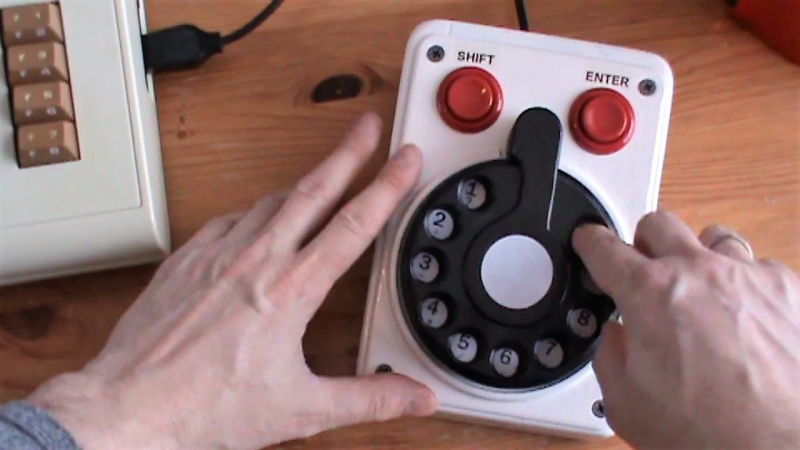Right up front, let us stipulate that we are not making fun of this project. Even its maker admits that it has no practical purpose. But this 3D-printed Commodore-style rotary dial keypad fails to be practical on so many levels that it’s worth celebrating.
And indeed, celebrating deprecated technology appears to be what [Jan Derogee] had in mind with this build. Rotary dials were not long ago the only way to place a call, and the last time we checked, pulse dialing was still supported by some telephone central office switchgear. Which brings us to the first failure: with millions of rotary dial phones available, why build one from scratch? [Jan] chalks it up to respect for the old tech, but in any case, the 3D-printed dial is a pretty good replica of the real thing. Granted, no real dial used a servo motor to return the dial to the resting state, but the 3D-printed springs [Jan] tried all returned the dial instantly, instead of the stately spin back that resulted in 10 pulses per second. And why this has been done up VIC-20 style and used as a keypad for Commodore computers? Beats us. It had to be used for something. That the software for the C-64 generates DTMF tones corresponding to the number dialed only adds to the wonderful weirdness of this. Check out the video below.
We’ll hand it to [Jan], he has a unique way of looking at the world, especially when it comes to clocks. We really enjoyed his persistence of phosphorescence clock, and his screw-driven linear clock turns the standard timekeeping UI on its head.
















I am a huge fan of rotary phones. I have bought a dozen of soviet-era phones dirt cheap. I use them for home automation. The ESP8266 inside a rotary phone detects clicks and sends them over MQTT to bla bla bla, you know the drill. So now if I want to turn on the light in the bedroom all you have to do is dial 5910. I like it, everyone else in my home hate it.
You can be sure you are on the right track if everyone else hates it.
Love this. Need to get my hands on more rotary phones…
Excellent video, brilliant idea.
Added new item on my to-do list: Dump 3DConnexion mouse and upgrade to a Rotary Dial Keypad.
Cool, but Commodore sorta beat him to it.
http://www.classicrotaryphones.com/forum/index.php?action=dlattach;topic=17125.0;attach=150532;image
I want to see a Western Electric 1500 or 2500 with it’s keypad replaced with as large a color touchscreen as will fit. Could make a smartphone out of it and hang the whole thing off a belt.
Funnnny vid. Finger Stop is in wrong/wrong place. Still have HeXpads and standard ten-key. Some with USB. TYVM. It was and is a major bitch using the numeral row on standard Qwerty keyboard but had to start somewhere. Commodores where easy to matrix out another pad right from the keyboard connector. Was third project after reset button and 22/44 card edge bus on VIC 20. Dont think I ever considered rotary dial as input. Maybe make a Hexadecimal rotary dial next?
Back around 1960, my friend Tim rented a 2nd floor apartment in an old victorian house near Kent State. From the outside it looked like a haunted house, but inside, everything was remotely controlled using rotary dials. They were in the kitchen, the livingroom, beside the throne in the bathroom and, of course, in the bedroom. Turning on a lamp was accompied by the glorious sounds of relays, latches and steppers springing into action. The system was designed by Tim’s gifted EE brother at Case Institute of Technology, and the wiring was well concealed. That was almost 60 years ago and it’s hard to believe that people are still trying to build a “smart house”.
I am just old enough to have originally learned to operate a rotary phone as a young child. I was still in elementary school as everything was switching over. I suppose they were pretty normal to me then although I barely remember.
Anyway, I found one at a thrift shop when I was in college. I thought it would be cool to put in the living room of my shared college apartment just to be different. It had been several years since I had used one.
I couldn’t believe how slow it was! I hadn’t remembered it that way. I think I called out from that phone about twice in the 2.5 years I lived there. I couldn’t stand to wait so long between digits.
I don’t know what happened to that phone. It’s gone now. I kind of wish I still had it as I have a VoIP box I would like to plug it into just to verify that the VoIP box really is that far backwards compatible. Of course that would be the only time I ever use it so I guess it’s not much of a loss.
When I was a child, any sufficiently advanced technology included a telephone dial. Wow wee!